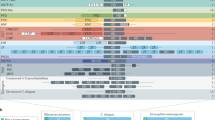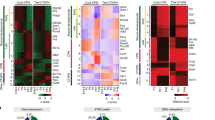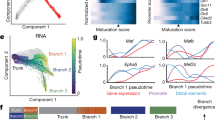Abstract
The identity of specific cell types in the nervous system is defined by the expression of neuron type–specific gene batteries. How the expression of such batteries is initiated during nervous system development has been under intensive study over the past few decades. However, comparatively little is known about how gene batteries that define the terminally differentiated state of a neuron type are maintained throughout the life of an animal. Here we provide an overview of studies in invertebrate and vertebrate model systems that have carved out the general and not commonly appreciated principle that neuronal identity is maintained in postmitotic neurons by the sustained, and often autoregulated, expression of the same transcription factors that initiate terminal differentiation in a developing organism. Disruption of postmitotic maintenance mechanisms may result in neuropsychiatric and neurodegenerative conditions.
This is a preview of subscription content, access via your institution
Access options
Subscribe to this journal
Receive 12 print issues and online access
$209.00 per year
only $17.42 per issue
Buy this article
- Purchase on Springer Link
- Instant access to full article PDF
Prices may be subject to local taxes which are calculated during checkout

Similar content being viewed by others
References
Masland, R.H. Neuronal cell types. Curr. Biol. 14, R497–R500 (2004).
Nelson, S.B., Sugino, K. & Hempel, C.M. The problem of neuronal cell types: a physiological genomics approach. Trends Neurosci. 29, 339–345 (2006).
Hobert, O., Carrera, I. & Stefanakis, N. The molecular and gene regulatory signature of a neuron. Trends Neurosci. 33, 435–445 (2010).
Fishell, G. & Heintz, N. The neuron identity problem: form meets function. Neuron 80, 602–612 (2013).
Flavell, S.W. & Greenberg, M.E. Signaling mechanisms linking neuronal activity to gene expression and plasticity of the nervous system. Annu. Rev. Neurosci. 31, 563–590 (2008).
Spitzer, N.C. Activity-dependent neurotransmitter respecification. Nat. Rev. Neurosci. 13, 94–106 (2012).
Achim, K., Salminen, M. & Partanen, J. Mechanisms regulating GABAergic neuron development. Cell. Mol. Life Sci. 71, 1395–1415 (2013).
Holmberg, J. & Perlmann, T. Maintaining differentiated cellular identity. Nat. Rev. Genet. 13, 429–439 (2012).
Hobert, O. Neurogenesis in the nematode Caenorhabditis elegans. WormBook (ed. The C. elegans Research Community) 10.1895/wormbook.1.12.2 〈http://www.wormbook.org/〉 (2010).
Hobert, O. Regulation of terminal differentiation programs in the nervous system. Annu. Rev. Cell Dev. Biol. 27, 681–696 (2011).
Etchberger, J.F. et al. The molecular signature and cis-regulatory architecture of a C. elegans gustatory neuron. Genes Dev. 21, 1653–1674 (2007).
Kratsios, P., Stolfi, A., Levine, M. & Hobert, O. Coordinated regulation of cholinergic motor neuron traits through a conserved terminal selector gene. Nat. Neurosci. 15, 205–214 (2012).
Duggan, A., Ma, C. & Chalfie, M. Regulation of touch receptor differentiation by the Caenorhabditis elegans mec-3 and unc-86 genes. Development 125, 4107–4119 (1998).
Wenick, A.S. & Hobert, O. Genomic cis-regulatory architecture and trans-acting regulators of a single interneuron-specific gene battery in C. elegans. Dev. Cell 6, 757–770 (2004).
Eastman, C., Horvitz, H.R. & Jin, Y. Coordinated transcriptional regulation of the unc-25 glutamic acid decarboxylase and the unc-47 GABA vesicular transporter by the Caenorhabditis elegans UNC-30 homeodomain protein. J. Neurosci. 19, 6225–6234 (1999).
Doitsidou, M. et al. A combinatorial regulatory signature controls terminal differentiation of the dopaminergic nervous system in C. elegans. Genes Dev. 27, 1391–1405 (2013).
Etchberger, J.F., Flowers, E.B., Poole, R.J., Bashllari, E. & Hobert, O. Cis-regulatory mechanisms of left/right asymmetric neuron-subtype specification in C. elegans. Development 136, 147–160 (2009).
Serrano-Saiz, E. et al. Modular control of glutamatergic neuronal identity in C. elegans by distinct homeodomain proteins. Cell 155, 659–673 (2013).
Flames, N. & Hobert, O. Gene regulatory logic of dopamine neuron differentiation. Nature 458, 885–889 (2009).
Chang, S., Johnston, R.J. Jr., Frokjaer-Jensen, C., Lockery, S. & Hobert, O. MicroRNAs act sequentially and asymmetrically to control chemosensory laterality in the nematode. Nature 430, 785–789 (2004).
O'Meara, M.M., Zhang, F. & Hobert, O. Maintenance of neuronal laterality in Caenorhabditis elegans through MYST histone acetyltransferase complex components LSY-12, LSY-13 and LIN-49. Genetics 186, 1497–1502 (2010).
Jafari, S. et al. Combinatorial activation and repression by seven transcription factors specify Drosophila odorant receptor expression. PLoS Biol. 10, e1001280 (2012).
Hsiao, H.Y., Jukam, D., Johnston, R. & Desplan, C. The neuronal transcription factor erect wing regulates specification and maintenance of Drosophila R8 photoreceptor subtypes. Dev. Biol. 381, 482–490 (2013).
Eade, K.T., Fancher, H.A., Ridyard, M.S. & Allan, D.W. Developmental transcriptional networks are required to maintain neuronal subtype identity in the mature nervous system. PLoS Genet. 8, e1002501 (2012).
Coppola, E., d'Autreaux, F., Rijli, F.M. & Brunet, J.F. Ongoing roles of Phox2 homeodomain transcription factors during neuronal differentiation. Development 137, 4211–4220 (2010).
Kadkhodaei, B. et al. Transcription factor Nurr1 maintains fiber integrity and nuclear-encoded mitochondrial gene expression in dopamine neurons. Proc. Natl. Acad. Sci. USA 110, 2360–2365 (2013).
Kadkhodaei, B. et al. Nurr1 is required for maintenance of maturing and adult midbrain dopamine neurons. J. Neurosci. 29, 15923–15932 (2009).
Schmidt, M. et al. The bHLH transcription factor Hand2 is essential for the maintenance of noradrenergic properties in differentiated sympathetic neurons. Dev. Biol. 329, 191–200 (2009).
Song, N.N. et al. Adult raphe-specific deletion of lmx1b leads to central serotonin deficiency. PLoS ONE 6, e15998 (2011).
Zhao, Z.Q. et al. Lmx1b is required for maintenance of central serotonergic neurons and mice lacking central serotonergic system exhibit normal locomotor activity. J. Neurosci. 26, 12781–12788 (2006).
Zetterström, R.H. et al. Dopamine neuron agenesis in Nurr1-deficient mice. Science 276, 248–250 (1997).
Saucedo-Cardenas, O. et al. Nurr1 is essential for the induction of the dopaminergic phenotype and the survival of ventral mesencephalic late dopaminergic precursor neurons. Proc. Natl. Acad. Sci. USA 95, 4013–4018 (1998).
Hendricks, T.J. et al. Pet-1 ETS gene plays a critical role in 5-HT neuron development and is required for normal anxiety-like and aggressive behavior. Neuron 37, 233–247 (2003).
Ding, Y.Q. et al. Lmx1b is essential for the development of serotonergic neurons. Nat. Neurosci. 6, 933–938 (2003).
Cheng, L. et al. Lmx1b, Pet-1, and Nkx2.2 coordinately specify serotonergic neurotransmitter phenotype. J. Neurosci. 23, 9961–9967 (2003).
Pattyn, A., Goridis, C. & Brunet, J.-F. Specification of the central noradrenergic phenotype by the homeodomain gene Phox2b. Mol. Cell. Neurosci. 15, 235–243 (2000).
Pattyn, A., Morin, X., Cremer, H., Goridis, C. & Brunet, J.-F. The homeobox gene Phox2b is essential for the development of autonomic neural crest derivatives. Nature 399, 366–370 (1999).
Tsarovina, K. et al. Essential role of Gata transcription factors in sympathetic neuron development. Development 131, 4775–4786 (2004).
Hendershot, T.J. et al. Conditional deletion of Hand2 reveals critical functions in neurogenesis and cell type-specific gene expression for development of neural crest-derived noradrenergic sympathetic ganglion neurons. Dev. Biol. 319, 179–191 (2008).
Liu, C. et al. Pet-1 is required across different stages of life to regulate serotonergic function. Nat. Neurosci. 13, 1190–1198 (2010).
Stott, S.R. et al. Foxa1 and foxa2 are required for the maintenance of dopaminergic properties in ventral midbrain neurons at late embryonic stages. J. Neurosci. 33, 8022–8034 (2013).
Lopes, R., Verhey van Wijk, N., Neves, G. & Pachnis, V. Transcription factor LIM homeobox 7 (Lhx7) maintains subtype identity of cholinergic interneurons in the mammalian striatum. Proc. Natl. Acad. Sci. USA 109, 3119–3124 (2012).
Sun, Y. et al. A central role for Islet1 in sensory neuron development linking sensory and spinal gene regulatory programs. Nat. Neurosci. 11, 1283–1293 (2008).
Magno, L. et al. The integrity of cholinergic basal forebrain neurons depends on expression of Nkx2-1. Eur. J. Neurosci. 34, 1767–1782 (2011).
März, M., Seebeck, F. & Bartscherer, K. A Pitx transcription factor controls the establishment and maintenance of the serotonergic lineage in planarians. Development 140, 4499–4509 (2013).
Zhang, F. et al. The LIM and POU homeobox genes ttx-3 and unc-86 act as terminal selectors in distinct cholinergic and serotonergic neuron types. Development 141, 422–435 (2014).
Xue, D., Finney, M., Ruvkun, G. & Chalfie, M. Regulation of the mec-3 gene by the C. elegans homeoproteins UNC-86 and MEC-3. EMBO J. 11, 4969–4979 (1992).
Ptashne, M. The chemistry of regulation of genes and other things. J. Biol. Chem. 289, 5417–5435 (2014).
Way, J.C. & Chalfie, M. The mec-3 gene of Caenorhabditis elegans requires its own product for maintained expression and is expressed in three neuronal cell types. Genes Dev. 3, 1823–1833 (1989).
Sarafi-Reinach, T.R., Melkman, T., Hobert, O. & Sengupta, P. The lin-11 LIM homeobox gene specifies olfactory and chemosensory neuron fates in C. elegans. Development 128, 3269–3281 (2001).
Bertrand, V. & Hobert, O. Linking asymmetric cell division to the terminal differentiation program of postmitotic neurons in C. elegans. Dev. Cell 16, 563–575 (2009).
Cochella, L. et al. Two distinct types of neuronal asymmetries are controlled by the Caenorhabditis elegans zinc finger transcription factor die-1. Genes Dev. 28, 34–43 (2014).
Craven, S.E. et al. Gata2 specifies serotonergic neurons downstream of sonic hedgehog. Development 131, 1165–1173 (2004).
Krueger, K.C. & Deneris, E.S. Serotonergic transcription of human FEV reveals direct GATA factor interactions and fate of Pet-1–deficient serotonin neuron precursors. J. Neurosci. 28, 12748–12758 (2008).
Ninkovic, J. et al. The transcription factor Pax6 regulates survival of dopaminergic olfactory bulb neurons via crystallin alphaA. Neuron 68, 682–694 (2010).
Tsarovina, K. et al. The Gata3 transcription factor is required for the survival of embryonic and adult sympathetic neurons. J. Neurosci. 30, 10833–10843 (2010).
Boukhtouche, F. et al. RORalpha, a pivotal nuclear receptor for Purkinje neuron survival and differentiation: from development to ageing. Cerebellum 5, 97–104 (2006).
Chen, X.R. et al. Mature Purkinje cells require the retinoic acid-related orphan receptor-alpha (RORalpha) to maintain climbing fiber mono-innervation and other adult characteristics. J. Neurosci. 33, 9546–9562 (2013).
Koike, C. et al. Functional roles of Otx2 transcription factor in postnatal mouse retinal development. Mol. Cell. Biol. 27, 8318–8329 (2007).
Martinez-Morales, J.R., Signore, M., Acampora, D., Simeone, A. & Bovolenta, P. Otx genes are required for tissue specification in the developing eye. Development 128, 2019–2030 (2001).
Béby, F. et al. Otx2 gene deletion in adult mouse retina induces rapid RPE dystrophy and slow photoreceptor degeneration. PLoS ONE 5, e11673 (2010).
Housset, M. et al. Loss of Otx2 in the adult retina disrupts retinal pigment epithelium function, causing photoreceptor degeneration. J. Neurosci. 33, 9890–9904 (2013).
Mears, A.J. et al. Nrl is required for rod photoreceptor development. Nat. Genet. 29, 447–452 (2001).
Montana, C.L. et al. Reprogramming of adult rod photoreceptors prevents retinal degeneration. Proc. Natl. Acad. Sci. USA 110, 1732–1737 (2013).
Liu, A. & Joyner, A.L. Early anterior/posterior patterning of the midbrain and cerebellum. Annu. Rev. Neurosci. 24, 869–896 (2001).
Simon, H.H., Saueressig, H., Wurst, W., Goulding, M.D. & O'Leary, D.D. Fate of midbrain dopaminergic neurons controlled by the engrailed genes. J. Neurosci. 21, 3126–3134 (2001).
Albéri, L., Sgado, P. & Simon, H.H. Engrailed genes are cell-autonomously required to prevent apoptosis in mesencephalic dopaminergic neurons. Development 131, 3229–3236 (2004).
Simon, H.H., Thuret, S. & Alberi, L. Midbrain dopaminergic neurons: control of their cell fate by the engrailed transcription factors. Cell Tissue Res. 318, 53–61 (2004).
Alvarez-Fischer, D. et al. Engrailed protects mouse midbrain dopaminergic neurons against mitochondrial complex I insults. Nat. Neurosci. 14, 1260–1266 (2011).
Fox, S.R. & Deneris, E.S. Engrailed is required in maturing serotonin neurons to regulate the cytoarchitecture and survival of the dorsal raphe nucleus. J. Neurosci. 32, 7832–7842 (2012).
Li, J.Y., Lao, Z. & Joyner, A.L. Changing requirements for Gbx2 in development of the cerebellum and maintenance of the mid/hindbrain organizer. Neuron 36, 31–43 (2002).
Bovetti, S. et al. COUP-TFI controls activity-dependent tyrosine hydroxylase expression in adult dopaminergic olfactory bulb interneurons. Development 140, 4850–4859 (2013).
Kosaka, T., Kosaka, K., Hama, K., Wu, J.Y. & Nagatsu, I. Differential effect of functional olfactory deprivation on the GABAergic and catecholaminergic traits in the rat main olfactory bulb. Brain Res. 413, 197–203 (1987).
Baker, H., Morel, K., Stone, D.M. & Maruniak, J.A. Adult naris closure profoundly reduces tyrosine hydroxylase expression in mouse olfactory bulb. Brain Res. 614, 109–116 (1993).
Cave, J.W. & Baker, H. Dopamine systems in the forebrain. Adv. Exp. Med. Biol. 651, 15–35 (2009).
Demarque, M. & Spitzer, N.C. Activity-dependent expression of Lmx1b regulates specification of serotonergic neurons modulating swimming behavior. Neuron 67, 321–334 (2010).
Dulcis, D., Jamshidi, P., Leutgeb, S. & Spitzer, N.C. Neurotransmitter switching in the adult brain regulates behavior. Science 340, 449–453 (2013).
Liu, N. & Baker, H. Activity-dependent Nurr1 and NGFI-B gene expression in adult mouse olfactory bulb. Neuroreport 10, 747–751 (1999).
Francis, N.J. & Landis, S.C. Cellular and molecular determinants of sympathetic neuron development. Annu. Rev. Neurosci. 22, 541–566 (1999).
Grant, M.P., Francis, N.J. & Landis, S.C. The role of acetylcholine in regulating secretory responsiveness in rat sweat glands. Mol. Cell. Neurosci. 6, 32–42 (1995).
Stanke, M. et al. Target-dependent specification of the neurotransmitter phenotype: cholinergic differentiation of sympathetic neurons is mediated in vivo by gp 130 signaling. Development 133, 141–150 (2006).
Apostolova, G., Loy, B., Dorn, R. & Dechant, G. The sympathetic neurotransmitter switch depends on the nuclear matrix protein Satb2. J. Neurosci. 30, 16356–16364 (2010).
Shilatifard, A. Molecular implementation and physiological roles for histone H3 lysine 4 (H3K4) methylation. Curr. Opin. Cell Biol. 20, 341–348 (2008).
Ptashne, M. Epigenetics: core misconcept. Proc. Natl. Acad. Sci. USA 110, 7101–7103 (2013).
Gold, D.A. et al. RORalpha coordinates reciprocal signaling in cerebellar development through sonic hedgehog and calcium-dependent pathways. Neuron 40, 1119–1131 (2003).
Serra, H.G. et al. RORalpha-mediated Purkinje cell development determines disease severity in adult SCA1 mice. Cell 127, 697–708 (2006).
Holmes, A., Yang, R.J., Lesch, K.P., Crawley, J.N. & Murphy, D.L. Mice lacking the serotonin transporter exhibit 5-HT(1A) receptor-mediated abnormalities in tests for anxiety-like behavior. Neuropsychopharmacology 28, 2077–2088 (2003).
Richardson-Jones, J.W. et al. Serotonin-1A autoreceptors are necessary and sufficient for the normal formation of circuits underlying innate anxiety. J. Neurosci. 31, 6008–6018 (2011).
Donaldson, Z.R. et al. Developmental effects of serotonin 1A autoreceptors on anxiety and social behavior. Neuropsychopharmacology 39, 291–302 (2014).
Veenstra-VanderWeele, J. & Blakely, R.D. Networking in autism: leveraging genetic, biomarker and model system findings in the search for new treatments. Neuropsychopharmacology 37, 196–212 (2012).
Waider, J., Araragi, N., Gutknecht, L. & Lesch, K.P. Tryptophan hydroxylase-2 (TPH2) in disorders of cognitive control and emotion regulation: a perspective. Psychoneuroendocrinology 36, 393–405 (2011).
Murphy, D.L. & Lesch, K.P. Targeting the murine serotonin transporter: insights into human neurobiology. Nat. Rev. Neurosci. 9, 85–96 (2008).
Deneris, E.S. & Wyler, S.C. Serotonergic transcriptional networks and potential importance to mental health. Nat. Neurosci. 15, 519–527 (2012).
Decressac, M., Volakakis, N., Bjorklund, A. & Perlmann, T. NURR1 in Parkinson disease–from pathogenesis to therapeutic potential. Nature reviews. Neurology 9, 629–636 (2013).
Volakakis, N. et al. NR4A orphan nuclear receptors as mediators of CREB-dependent neuroprotection. Proc. Natl. Acad. Sci. USA 107, 12317–12322 (2010).
Chu, Y. et al. Nurr1 in Parkinson's disease and related disorders. J. Comp. Neurol. 494, 495–514 (2006).
Le, W.D. et al. Mutations in NR4A2 associated with familial Parkinson disease. Nat. Genet. 33, 85–89 (2003).
Farrer, M. et al. Comparison of kindreds with parkinsonism and alpha-synuclein genomic multiplications. Ann. Neurol. 55, 174–179 (2004).
Decressac, M. et al. alpha-synuclein–induced down-regulation of Nurr1 disrupts GDNF signaling in nigral dopamine neurons. Sci. Transl. Med. 4, 163ra156 (2012).
Acknowledgements
We thank D. Allan, P. Kratsios, N. Flames, P. Sengupta, S. Wyler and C. Spencer for comments before submission. We are indebted to M. Ptashne for his insightful comments and suggestions throughout the writing of this review. The authors are funded by the US National Institutes of Health (R01NS039996 and R01NS050266-03 to O.H. and RO1MH062723 and P50MH096972 to E.S.D.) and the Howard Hughes Medical Institute (O.H.).
Author information
Authors and Affiliations
Corresponding authors
Ethics declarations
Competing interests
The authors declare no competing financial interests.
Rights and permissions
About this article
Cite this article
Deneris, E., Hobert, O. Maintenance of postmitotic neuronal cell identity. Nat Neurosci 17, 899–907 (2014). https://doi.org/10.1038/nn.3731
Received:
Accepted:
Published:
Issue Date:
DOI: https://doi.org/10.1038/nn.3731
This article is cited by
-
Neurexin-1-dependent circuit activity is required for the maintenance of photoreceptor subtype identity in Drosophila
Molecular Brain (2024)
-
Baf-mediated transcriptional regulation of teashirt is essential for the development of neural progenitor cell lineages
Experimental & Molecular Medicine (2024)
-
The transcription factor unc-130/FOXD3/4 contributes to the biphasic calcium response required to optimize avoidance behavior
Scientific Reports (2022)
-
Novel role for mineralocorticoid receptors in control of a neuronal phenotype
Molecular Psychiatry (2021)
-
KAT3-dependent acetylation of cell type-specific genes maintains neuronal identity in the adult mouse brain
Nature Communications (2020)



